History of the Budweiser Logo Design & Evolution
Few symbols in the history of American brewing are as prominent as the Budweiser logo.
Initially created in 1876 as a small emblem, it has become a transcendent icon that reflects changing consumer preferences and the ceaseless innovation of one of America’s most revered brands.
The Budweiser logo is made with great care and based on centuries-old brewing techniques; it is more than something to look at.
It stands for Adolphus Busch’s unyielding determination to create a beer that all Americans would love. Every version of this logo — from the earliest ornate ones to its sleek digital-age redesigns — speaks volumes about adaptability and foresight.
- The Budweiser logo, created in 1876, reflects adaptability and innovation in response to changing consumer preferences.
- Key figures like George Schneider and William D’Oench played significant roles in the logo's development and evolution.
- Symbolism in the logo conveys values of quality, tradition, and excellence, contributing to Budweiser's iconic status and brand loyalty.
Early Beginnings of the Budweiser Logo
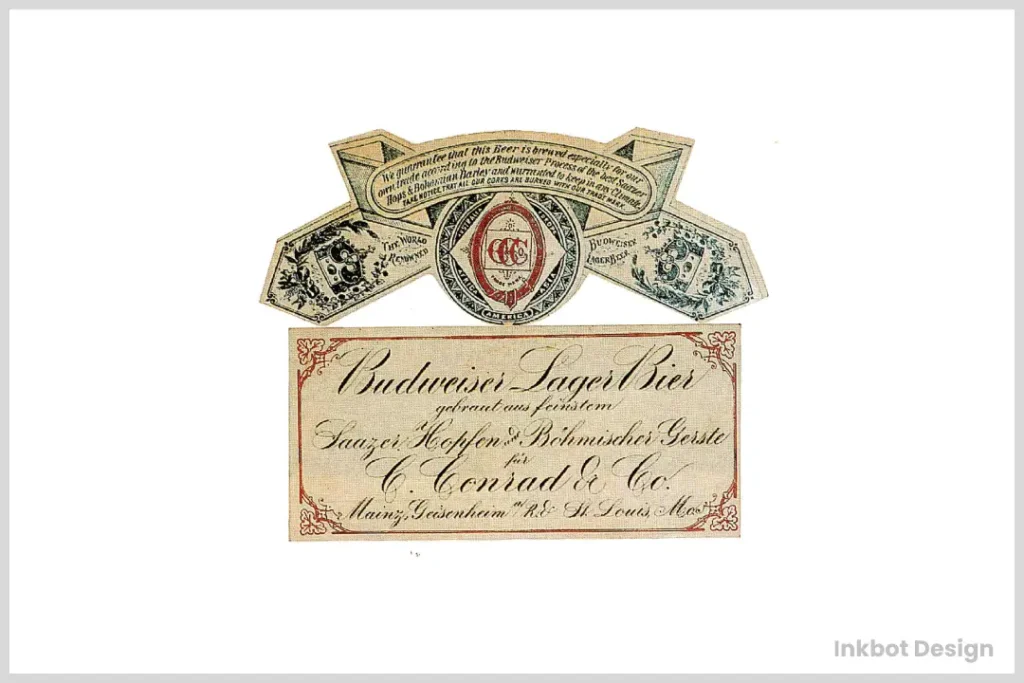
The year 1876 saw the birth of the Budweiser logo, considered one of the most significant moments in Anheuser-Busch’s history, as it was done during its establishment.
Adolphus Busch aimed to transform the American beer market through this move by creating a unique logo that would match his idea of fusing European brewing traditions with American consumer preferences.
But beyond being just an emblem to represent it visually, this sign represented everything he wished for – a nationwide beer brand that could produce industry-level quality and artistry standards under any competition.
One characteristic feature displayed by early forms of Budweiser logos is their highly elaborate design patterns; they were created like this because those involved wanted them to be perfect in every sense, showing how much attention to detail Anheuser-Busch paid then (and now).
In other words, these initial models showed off what can be described as artistic skills or talents put into practice.
It sets high levels of quality, which become synonymous with the name “Budweiser” later on and also brings about sophistication within the company itself. Doing so gave people an idea about what should be expected from such a mark: nothing less than perfectionism when brewing beer.
Key Figures in Budweiser Logo Development
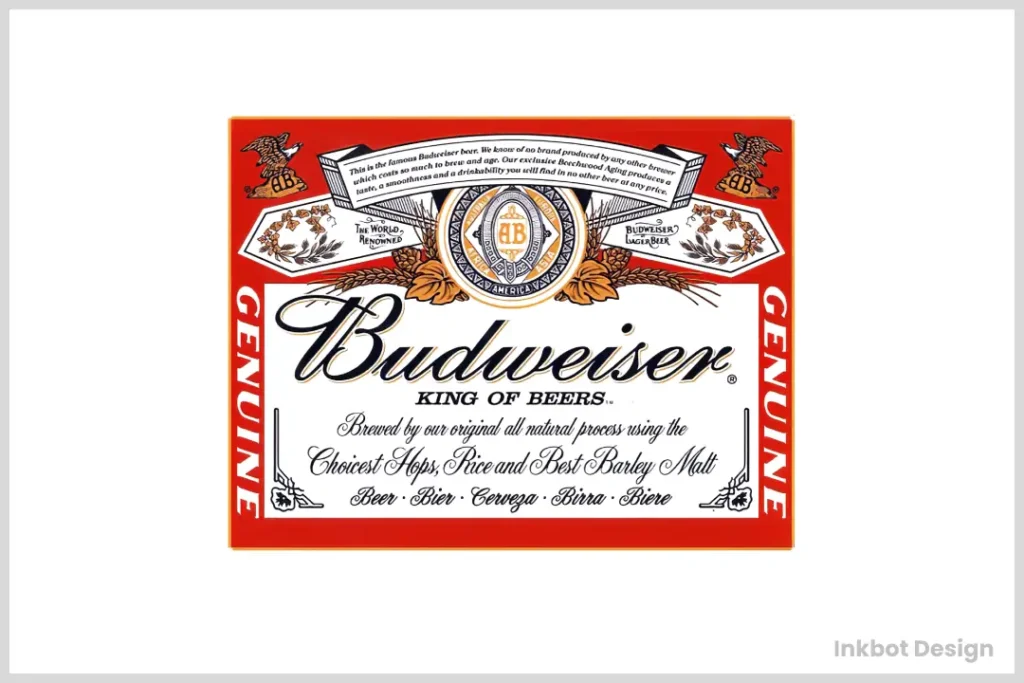
George Schneider is one of the prominent people behind the Budweiser logo’s development; he was a close associate of Adolphus Busch, who came up with most early design concepts based on his creativity.
Schneider had vast knowledge of designing stuff and paying attention to details, which played a massive role in creating an attractive logo to visually communicate this product’s values and aspirations among its consumers.
Contributions like those made by him led to what can be described today as the iconic status achieved by the Budweiser logo within the beer market.
William D’Oench also significantly contributed towards transforming Budweiser’s emblem; his strategic thinking skills and understanding of customer preferences were vital in shaping aspects related to appearance, thus making it visually appealing.
He used to know everything about designs looking good or bad according to current taste trends, then apply some suitable elements that likely resonate better with the desired target group, increasing their attraction and making them easily identifiable, apart from just being seen alone.
What happened here is that D’Oench worked closely alongside Busch and Schneider so that apart from reflecting the nature of these brands, they could effectively convey their values through logos, laying the foundation for continuous growth success recognition within the broader business environment.
Evolution of the Budweiser Logo
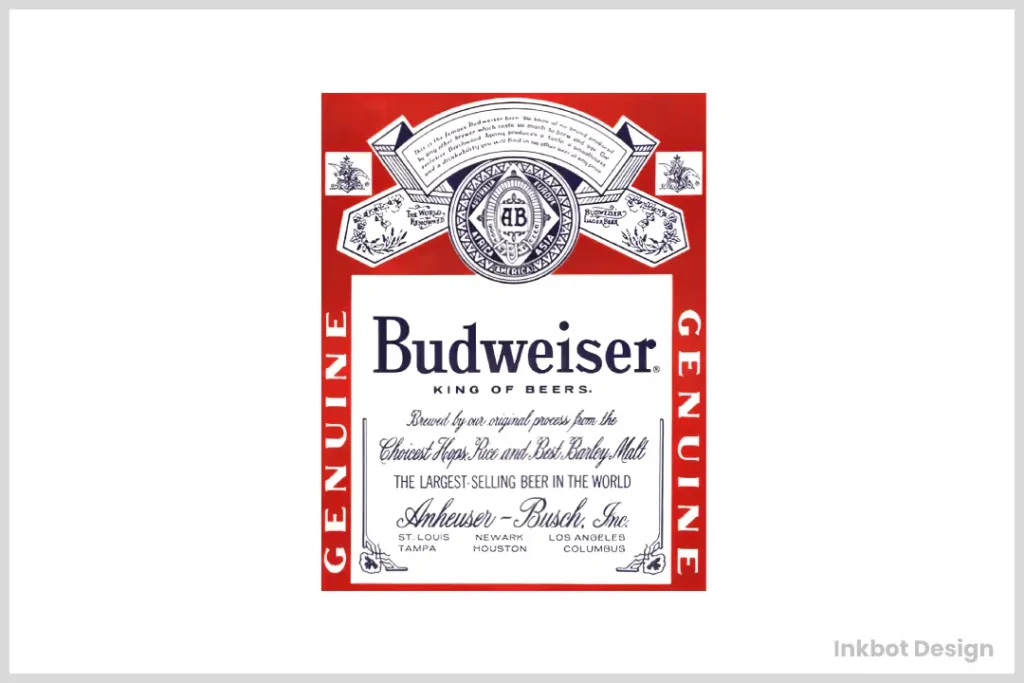
The Budweiser logo’s evolution demonstrates the capacity of the brand to adjust and respond to changes in consumer preferences and design fashions with innovation.
From its beginnings with intricate script-like labels to today’s sleek and minimalist design, the logo has changed several times over the years as it reflects on the journey and growth that this company has gone through.
Each time they redesigned their logo, it was a strategic move based on what was happening in markets around them so that they could always stay relevant while continuing to attract those who drink their beer.
One way they did this was by going from decorative and ornate designs into something cleaner and more modern, showing how adaptable Budweiser is as a brand and their commitment to staying in touch with what’s current.
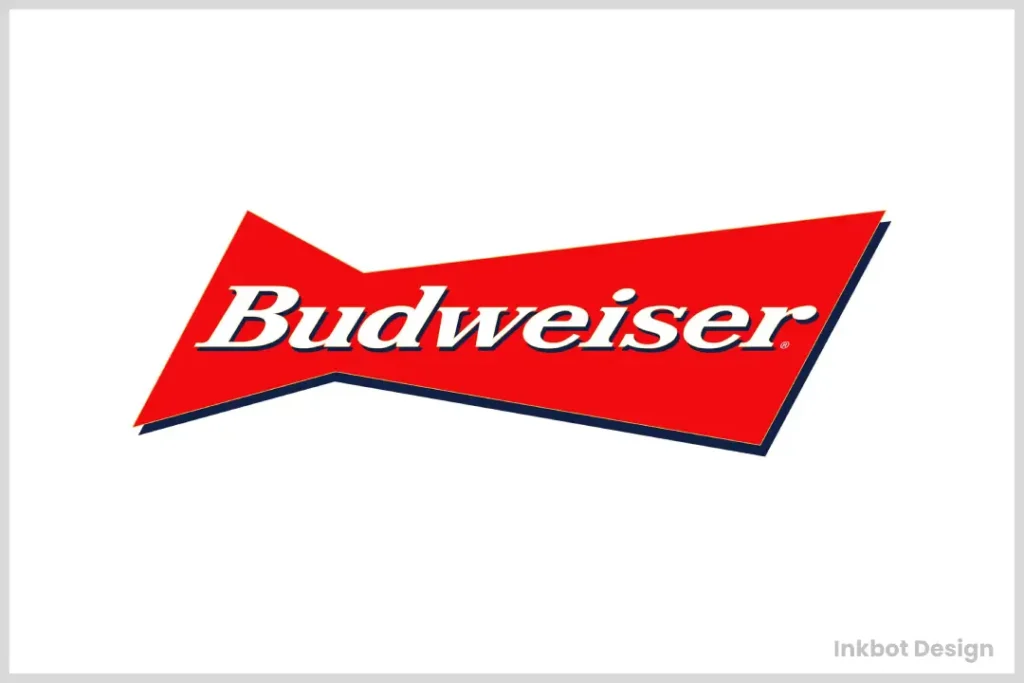
The bold reds mixed with whites make them accessible to the eyes but also hard not to notice when looking at them, which might explain why most people recognise those colours immediately.
Another thing is that bow-tie shapes and gold crowns are two other vital parts you would see at first glance, making this label unique among all others found throughout the beer industry today.
Furthermore, embracing new trends like digital optimisation through the 2016 re-design indicates that Budweiser can use design to improve how visible or interactive brands become known among consumers, thus proving itself flexible whenever required by market conditions.
However, we have also seen transformations take place visually and narratively, where these changes tell stories about creativity & invention, shaping identities & positions within markets for themselves – What makes an organisation successful over time?
Can something old-fashioned, such as logo designs representing tradition, continue appealing to generation after generation?
Design Elements and Symbolism
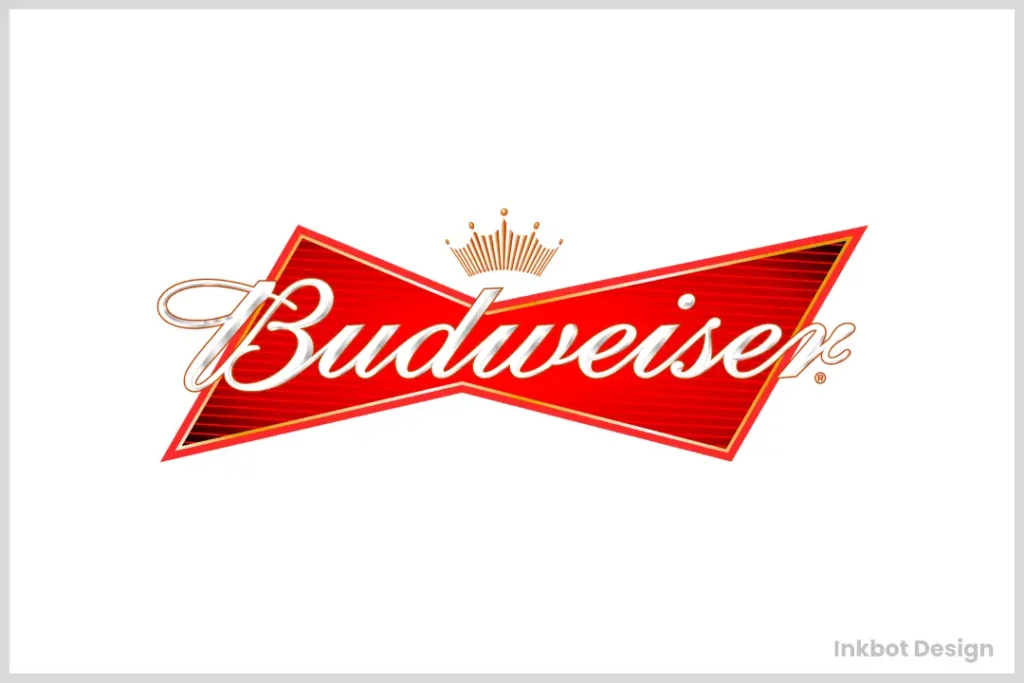
Budweiser logo’s design has many symbols representing what the brand stands for and where it comes from.
The bowtie is a unique part of this logo and shows that Budweiser always wants to move forward and try new things because they’re constantly evolving as a company.
It’s also like a visual representation of their flexibility with changing times or trends–they can fit anywhere! That golden crown might be another thing you notice about the design; if so, good eye! It’s meant to signify kingship over all other beers.
This means it shows off how long-established they are and how much better than everyone else at making beer, too!
Aside from these features, though, we can’t ignore those three colours, red, white, and gold – why were they chosen?
Well, simply put, each one tells us something different when combined within one image, such as this logo represents America’s history (or traditions)
So, let me break it down for you: Red stands for courage, strength, and love, while white signifies purity, innocence, and peace. Finally, gold represents wealth and success.
And if I’ve learned anything over the years, colour can make or break a piece, which is why the red, white, and gold colour scheme in the Budweiser logo is so important.
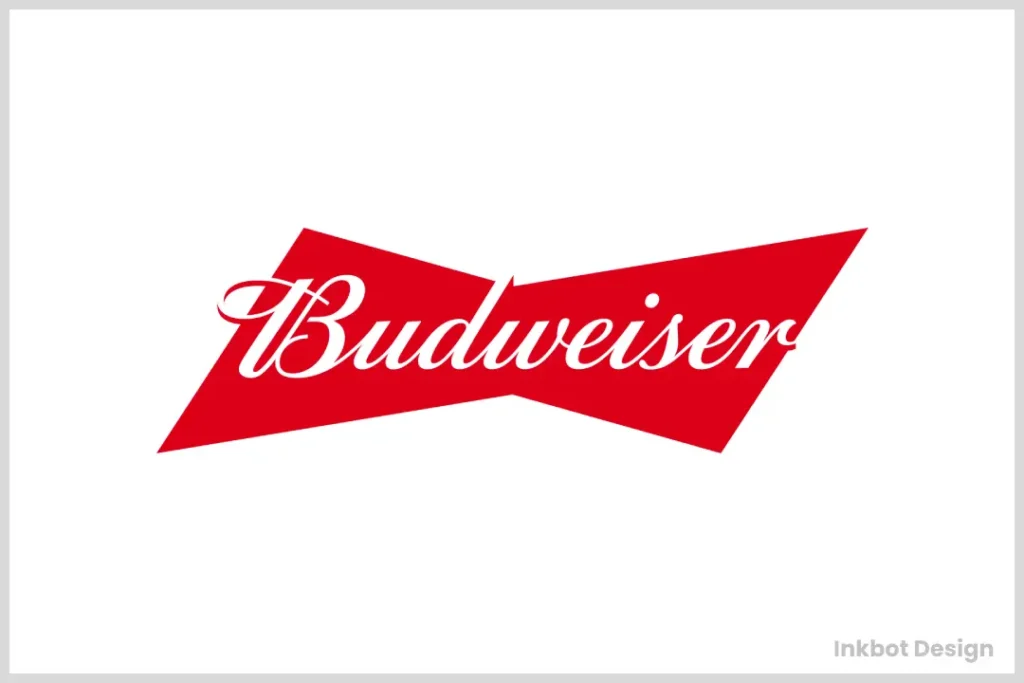
Red symbolises passion – an attribute necessary when brewing beer at such high volumes as they do! Not only that but also energy; think about how energised you would get after drinking one too many cans during football season…
White on its own may seem bland, but paired with other colours like these, it creates a sense of tradition which ties into their long-standing history as America’s favourite brewer since 1876 (or whatever year was written there)
And then there’s gold, representing excellence; this should come as no surprise, as though bud has existed since before most people were born.
I’ve got to hand it to them for being so clever with their logo. They did a great job of including everything that represents what they’re all about without making it too complicated.
Impact on Branding and Marketing Strategies
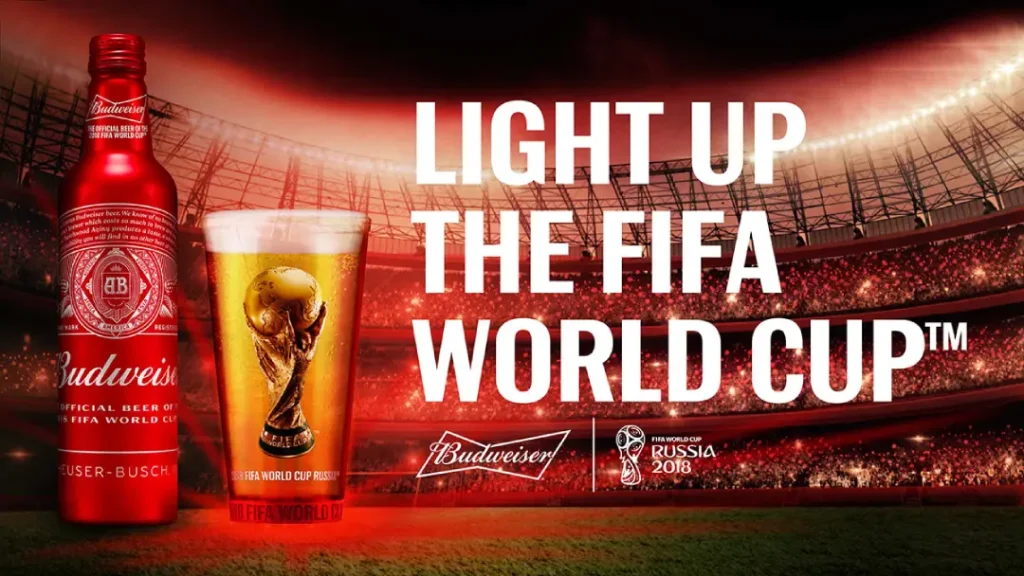
The Budweiser logo is a big deal in branding and marketing.
It changes what people think of products, makes people stick with the brand they like best, and helps them know who’s in charge. The style of the logo doesn’t change much each time they use it, but it always has a gold crown, bowtie pattern and matching colours, so you can easily remember what it looks like.
Do you have to keep seeing an ad repeatedly or any other kind of exposure with Budweiser logos on them all day? That was no accident!
They put them on purpose because everyone realises that seeing these signs will help reinforce their presence in consumers’ minds. These commercials aren’t just there for show either; this company knows how important loyalty is, so they want people looking at their stuff and liking it, too!
One thing that sets Budweiser apart from other companies? They make sure their Clydesdale horses are always branded with the same logo as everything else.
This makes sense because if someone sees one horse walking around town without any context or words next to it, chances are high that they’ll still connect back to this famous beer company somehow.
Challenges Faced and Survival During Prohibition

How Anheuser-Busch withstood Prohibition proves how flexible, inventive and forward-thinking the company was when dealing with difficult situations.
Instead of giving up due to the Prohibition laws, the company showed great agility by diversifying into non-alcoholic products to keep its business running.
Anheuser-Busch used its knowledge in brewing and understanding of the market to change direction successfully towards manufacturing soft drinks and malt beverages, among other non-alcoholic drinks, which saved it from collapsing during one of America’s most troubled times.
The introduction of Prohibition did not only challenge but also build on Anheuser-Busch’s resilience in the market and brand establishment.
After surviving through these tough years and adapting according to what consumers wanted, the organisation became more vital; this move saw Budweiser become one of the leading beer brands nationally following its post-prohibition revival.
Such difficulties became lessons for future success and strategic choices made by Anheuser-Busch, which influenced their brand identity and positioning themselves within different markets over decades.
Additionally, innovative marketing strategies employed by Anheuser-Busch during Prohibition played a crucial role in ensuring that brands remained visible while keeping consumers engaged.
The Company maintained a connection with customers through creative branding activities and strategic partnering, reinforcing Budweiser’s presence within markets even further, leading into its post-prohibition comeback.
This shows they will always find ways around them no matter what happens or how bad things may seem. Their commitment to excellence never changes regardless of circumstances, showing perseverance even when everything else fails.
Trademark Dispute and Marketing Strategies
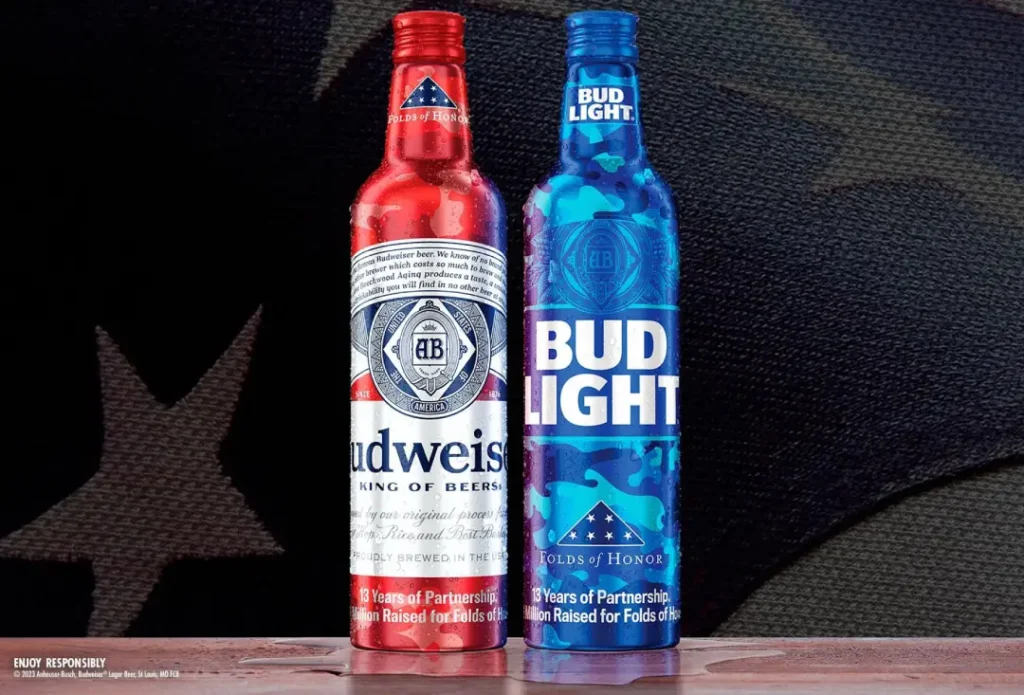
The ongoing trademark spat between Anheuser-Busch and Budweiser Budvar Brewery demonstrates the worldwide recognition and popularity of the beer brand.
The disagreement over “Budweiser” as a name shows how important this brand is in its market presence, indicating that both sides want to protect their identity and gain more shares.
Nevertheless, as complex legally tangled situations may be, Anheuser-Busch has shown itself skilled at dealing with them by being flexible enough to keep up with regionally distinct titles while still honouring what it means to be called “Budweiser”.
What’s even more exciting, though, is how Anheuser-Busch continued its creative marketing approach during the legal battle, which helped it stay number one even when faced with such challenges. For example, in some areas, lawsuits against using names such as ‘Budweiser’ were instead labelled as ‘Bud’.
This move served two purposes: showing an understanding of complex legal environments while preserving brand image and awareness simultaneously. In addition, this strategy ensures that brands remain cohesive and strengthens customer loyalty, leading to higher recognition levels and cementing Budweiser’s place as one of the top global beers known everywhere.
Moreover, sponsoring teams or significant sports events acted like foundation blocks for promotional activities by enhancing consumers’ emotional ties towards products through increased visibility among fans who attend these matches.
Recognition and Market Impact
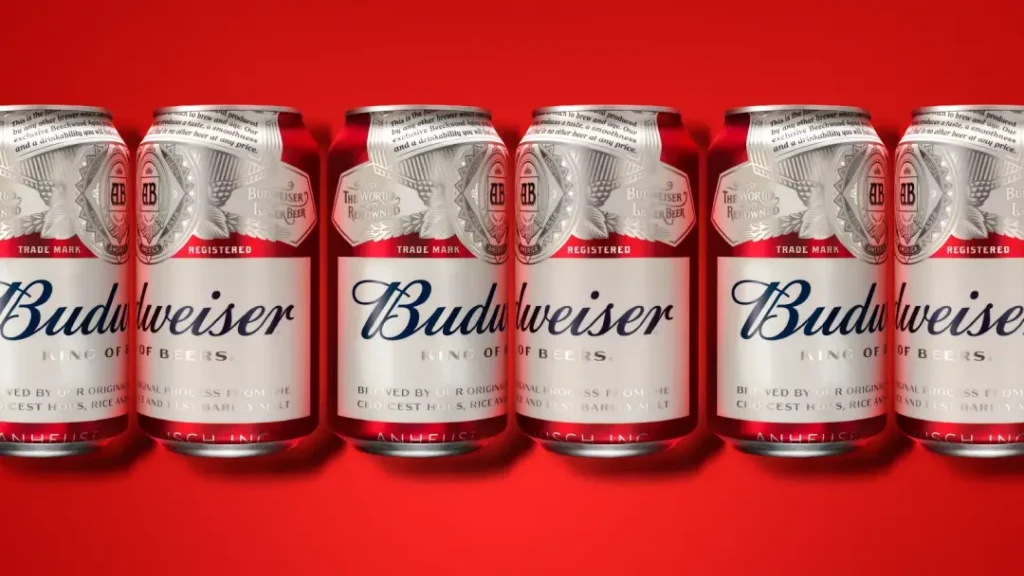
The Budweiser logo is a testament to its long-standing history and fame in the beer industry, as evidenced by its recognition and impact on the market.
The simplicity of design, choice of vivid colours, and symbolism in this logo resonate with buyers, who confirm that the product represents quality and tradition.
Sticking to conventional elements in creating logos and mixing them with modern ones has enabled Budweiser to remain relevant among different target markets, thus becoming one of America’s most loved beer brands.
One important thing about the Budweiser sign that accounts for why many people can identify it quickly or know about it widely is that it brings out feelings associated with tradition, passion, and excellence, which are part of what this name stands for as a company. For instance, the bow-tie shape and gold crown symbol, together with other features used within its design, represent specific values cherished by Budweiser throughout time, thereby making individuals connect emotionally towards them irrespective of their age brackets.
Such timeless appeal has helped establish Budweiser as an industry leader, thus demonstrating how much brands can do through logos alone.
In addition, being iconic and identifiable plays a significant role in shaping consumer choices while fostering loyalty towards given products/services – both locally & globally alike.
This means that when consumers view any visual representation (logo), they should be able to associate it directly with something specific, i.e., quality, craftsmanship, etc., therefore reinforcing such ideas into people’s minds over again so that eventually, those words become synonymous with each other wherever such an item may be found worldwide including premium beers like bud alcohol content by volume per cent being higher than average strength value among others too numerous mention here at once.
To achieve this goal more effectively, Budweiser has adopted these same elements during all their marketing campaigns, thereby ensuring consistent brand experience across different touchpoints where the customer interacts, leading to increased preference, hence building solid bonds between buyers themselves besides just endearing itself further into hearts every drinker who takes pride in drinking American made beer…
Conclusion
When we look at the Budweiser logo’s rich history and development, it becomes apparent that a lot happened. It is a narrative filled with novelty, high performance, and mastery of branding strategies, all of which have been instrumental in shaping the brand’s identity and position in the market.
The story behind this iconic symbol started in 1876 when it was first created. It stands among the most recognisable logos globally, representing Budweiser’s commitment to excellence tradition and visually engaging customers through their values and heritage.
What makes every version different from the other is that they were designed using creativity while considering adaptability, proving that even while changing according to time, they still keep their originality alive, thus making people relate to them no matter what era they come from.
This does not only talk about one thing; each change made to logo design tells different tales given birth by imagination, showing flexibility in thinking during various periods, hence connecting with users over many years. But what makes the Budweiser logo unique is not just how long it has been around or what stories can be told through its changes but also why these stories matter so much when building brands – because people remember them forever as part of themselves, having gone through their lives being influenced by advertising campaigns like these which reflect humanity at large.
If you are interested in logo design and branding, please visit inkbotdesign.com for more information. Inkbot Design is a leading agency that specialises in creating impactful identities for brands; their expertise lies with professional logo design, branding strategy development, and digital marketing services tailored towards positioning organisations across all sectors competitively within today’s dynamic business environment.

